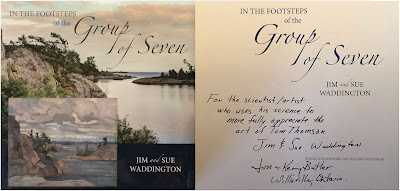 |
| The McElroys come to my Rescue on Petawawa Gorges, Night |
In 1976 when I graduated from Queens in Nuclear Physics, I was not aware of the friends that I would make forty years later in association with Tom Thomson. It turned out that several of my future Thomson friends were also involved in nuclear physics. Except for a twist of fate, I was also destined to go to Chalk River to study and work in the Nuclear Industry. Those friends would have been encountered that much sooner in Deep River and while paddling the Petawawa and the Dumoine. One can only ride one horse at a time, and meteorology came along first, so I saddled up. There can be no looking back but I often wonder..
Meanwhile, in July of 1977, Jim and Sue Waddington began a 36-year journey of discovery that culminated with "In the Footsteps of the Group of Seven" in 2013. Jim even went to the same high school in Brockville, graduating from BCIVS in 1959. Jim became a Professor of Physics at McMaster University with a specialty in Nuclear Physics.
 |
| My prized, autographed copy of Jim and Sue Waddington's book |
Diana and Bob McElroy began their investigations into the painting places of Tom Thomson in the 1980s. Bob McElroy also has a strong background in physics and worked at Chalk River. Diana and Bob have a large and significant web presence detailing the painting places of Tom Thomson. I found these sites to be invaluable when I was working on a previous Blog.
 |
| Diana and Bob McElroy have paddled along Tom Thomson's path for decades and written and photographed extensively about their travels. Link |
The spouses in these relationships were certainly equal partners in their life adventures as I can attest from my own personal experience. The wealth of information discovered by these teams on the art of Tom Thomson and the Group of Seven is simply extraordinary.
With great respect for their expertise, I presented the previous Blog "Tom Thomson's Petawawa Gorges; Night 1916" to Diana and Bob. The response was not what I hoped for:
"Based on real-life observations, I don't really think the two sketches you looked at were done in the same place, though I certainly see one might think that. Something to consider is that the canyon is quite narrow, while the walls at the Natch are somewhat farther apart. Of course, we can't know for sure and I may well be wrong. One thing that always has to be taken into account when looking for Tom's painting locations is his penchant for changing the aspect ratio of the scene in order to (I assume) fit what he wanted to include in a sketch to the proportions of his painting surface."
And herein can be found the value of having "boots on the ground". Bob and Diana had paddled to all of those Thomson painting locations. One can learn a lot by simply listening. I was all ears...
The McElroys "believe that the following sketch was painted at the Natch on the north Branch of the Petawawa River." With permission, I have reformatted their findings and reproduced them here to facilitate comparison.
On their website, the McElroys diplomatically presented both possibilities for the painting discussed in "Tom Thomson's Petawawa Gorges; Night 1916":
 | |
| "Petawawa Gorges, Night" as photographed at the Natch above. |
- If "Petawawa Gorges, Night" was painted at "The Natch", it is looking downstream and it is probably before dawn. (The illustration above.)
- If "Petawawa Gorges, Night" was painted in the Barron Canyon, the view is looking upstream after sunset with no nearby campsite to retreat to. (The illustration below.)
 |
| The best match for "Petawawa Gorges, Night" within the Barron Canyon. |
 |
| Vintage, Historical Map showing the canoe trip taken by Tom Thomson and Ed Godin in August 1916 as well as the disparate location of the two paintings as described above. |
"It had previously been our contention that most of the various Gorges of the Petawawa sketches were from the Barron Canyon and that at least reasonable matches could be found there. However, we were aware that a strong case could be made for Petawawa, Algonquin Park having been painted at The Natch on the north branch of the Petawawa River. In 2016 September, we travelled to the Natch to investigate further (see Trip Log - The Petawawa River from Lake Travers to McManus Lake).
On the basis of this visit, we have concluded that Petawawa, Algonquin Park and Petawawa Gorges, Night were painted there. If you are there with copies of the prints in hand you have no doubt that this was the painting location. But our photographs are not sufficient to prove the case. When you are there in person, your mind can see through the changes in vegetation and tolerate not being in the precise location in a way that it cannot do when only looking at photographs."
 |
| Petawawa Gorges, Night Alternate titles: Coming of Night; Sunset behind Cliff; Fall 1916 Oil on wood 8 5/16 x 10 1/2 in. (21.1 x 26.7 cm) Tom's Paint Box Size |
Warmest regards and keep your paddle in the water,
Phil Chadwick
PS: Tom Thomson Was A Weatherman - Summary As of Now contains all of the entries to date.

No comments:
Post a Comment